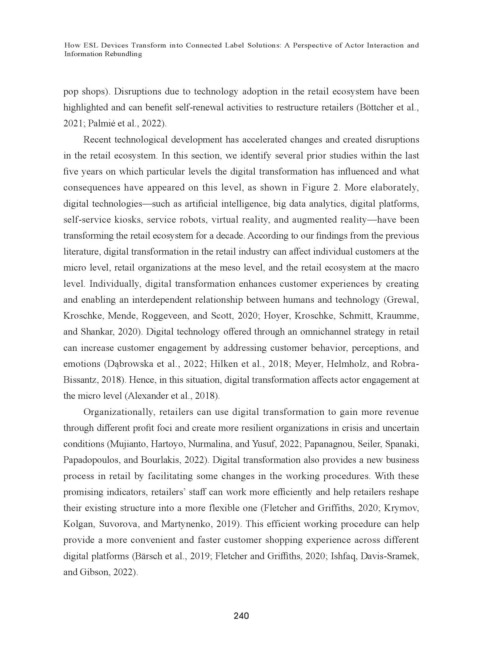Page 250 - 34-3
P. 250
How ESL Devices Transform into Connected Label Solutions: A Perspective of Actor Interaction and
Information Rebundling
pop shops). Disruptions due to technology adoption in the retail ecosystem have been
highlighted and can benefit self-renewal activities to restructure retailers (Böttcher et al.,
2021; Palmié et al., 2022).
Recent technological development has accelerated changes and created disruptions
in the retail ecosystem. In this section, we identify several prior studies within the last
five years on which particular levels the digital transformation has influenced and what
consequences have appeared on this level, as shown in Figure 2. More elaborately,
digital technologies—such as artificial intelligence, big data analytics, digital platforms,
self-service kiosks, service robots, virtual reality, and augmented reality—have been
transforming the retail ecosystem for a decade. According to our findings from the previous
literature, digital transformation in the retail industry can affect individual customers at the
micro level, retail organizations at the meso level, and the retail ecosystem at the macro
level. Individually, digital transformation enhances customer experiences by creating
and enabling an interdependent relationship between humans and technology (Grewal,
Kroschke, Mende, Roggeveen, and Scott, 2020; Hoyer, Kroschke, Schmitt, Kraumme,
and Shankar, 2020). Digital technology offered through an omnichannel strategy in retail
can increase customer engagement by addressing customer behavior, perceptions, and
emotions (Dąbrowska et al., 2022; Hilken et al., 2018; Meyer, Helmholz, and Robra-
Bissantz, 2018). Hence, in this situation, digital transformation affects actor engagement at
the micro level (Alexander et al., 2018).
Organizationally, retailers can use digital transformation to gain more revenue
through different profit foci and create more resilient organizations in crisis and uncertain
conditions (Mujianto, Hartoyo, Nurmalina, and Yusuf, 2022; Papanagnou, Seiler, Spanaki,
Papadopoulos, and Bourlakis, 2022). Digital transformation also provides a new business
process in retail by facilitating some changes in the working procedures. With these
promising indicators, retailers’ staff can work more efficiently and help retailers reshape
their existing structure into a more flexible one (Fletcher and Griffiths, 2020; Krymov,
Kolgan, Suvorova, and Martynenko, 2019). This efficient working procedure can help
provide a more convenient and faster customer shopping experience across different
digital platforms (Bärsch et al., 2019; Fletcher and Griffiths, 2020; Ishfaq, Davis-Sramek,
and Gibson, 2022).
240

